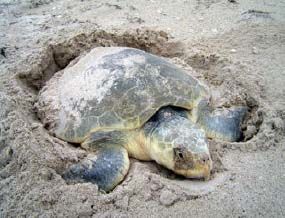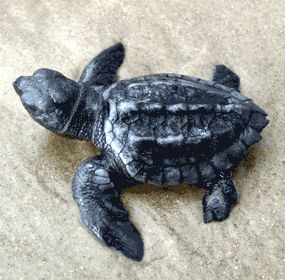As If Danger Weren’t Enough
Air Date: Week of June 18, 2010
 |
Scientists are racing against time to help save marine birds and other wildlife affected by the oil. National Wildlife Federation naturalist David Mizejewski describes the pelicans and turtles he’s seen in the Gulf. And, the Kemp’s Ridley sea turtle feeds and nests right in the path of the Gulf oil slick. So dependent on this stretch of coast for survival, this endangered sea turtle is particularly vulnerable to the effects of the spill. Host Jeff Young talks with Pat Burchfield, a scientist at Gladys Porter Zoo in Brownsville, Texas, who has studied the turtle for nearly four decades.
Transcript
YOUNG: It’s Living on Earth, I’m Jeff Young. On the Gulf Coast, the race is on to save oil-coated wildlife…
[FANS, BIRD SPLASHING]
YOUNG: The trained specialists at the seabird rehabilitation center in Fort Jackson, Louisiana, have cleaned oil from hundreds of brown pelicans so far. The Brown Pelican just came off the federal list of threatened species last year. Living on Earth’s Amanda Martinez took a tour with naturalist David Mizejewski of the National Wildlife Federation.
MIZEJEWSKI : Yeah, this is pretty tough to look at…these pelicans here are heavily oiled. Their whole bodies are a rusty reddy, nasty looking color…they’ve clearly been oiled head to toe. And the pelican’s natural reaction when it gets oil on its feathers, and this is true of most birds, is that they try to clean it off.
It’s imperative to keep their feathers in good condition because if they are not, they can’t fly. They lose their ability to regulate their temperature-the feathers provide insulation. They provide buoyancy in the water and for an animal like a pelican- they swim on the surface of the water.
So, if their feathers aren’t in good condition, they basically can’t survive. And, so, what they try to do is clean that off with their beaks, and in the process, not only does the oil not come off because it’s so viscous, but they wind up ingesting a lot of that oil- and when they do that, they get poisoned. So, these birds are polluted on the outside but they’re also polluted on the inside.
YOUNG: Reports from out on the water are equally discouraging. Government scientists found the carcass of an endangered sperm whale floating about 80 miles south of the Deepwater Horizon spill site. Further tests will determine what killed the whale. And the Wildlife Federation’s Mizejewski says people are also finding threatened and endangered sea turtles in the oil.

Nesting Kemp’s Ridley sea turtle. (National Park Service)
YOUNG: The Kemp’s Ridley sea turtle is of special concern. It’s critically endangered and nests only on a few beaches in the Gulf. Scientists like Pat Burchfield fear the timing of the spill, coming just as nestlings emerge, could spell trouble. Burchfield directs the Gladys Porter Zoo in Brownsville, Texas, and leads the US arm of the bi-national Kemp’s Ridley Sea Turtle Recovery Program. He’s studied the turtle for 38 years.
BURCHFIELD: It’s the smallest of the sea turtles. If an adult takes their arms and makes a circle that’s about the size of a Kemp’s Ridley turtle. And it has a very hawk-like, or parrot-like face, their appendages are adapted into flippers, so they’re very awkward on land, have a difficult time traversing the sandy beach. They have no reverse gear, they can’t turn around and go backwards. If they get up against a piece of driftwood, that’s where it ends.
YOUNG: So what’s your concern now, with the oil that’s out there in the Gulf now, how do you think that might affect the turtles?
BURCHFIELD: The hatchling turtles, after anywhere of a 42-62 day incubation time, make their way to the surface of the sand. And, once they’re ready to go, it’s like someone fired a starter gun. All the babies go into this frenzied behavior and crawl across the sand and out into the waiting surf. They have no real lung capacity when they first start out, but after they get roughly two miles offshore they can stay down for about three minutes and they’re swimming due east into the Gulf of Mexico.
And we suppose that these things are caught up in the Gulf current and they spend the next two or three years floating among sargassum and feeding on the small organisms that live among the sargassum weed. And that also is going to pick up oil and if you look on a map and watch where the Gulf loop current goes, it’s going to go up near shore waters, Texas, Louisiana, towards the mouth of the Mississippi. And that’s going to take those babies into harm’s way.
YOUNG: So these little turtles are basically traveling the same highway, if you will, that the oil is in the Gulf.
BURCHFIELD: Exactly.
YOUNG: So how might the turtles encounter the oil and be bothered by it?
BURCHFIELD: Well, they have to come to the surface to breathe- they’re reptiles and they’re air breathers. So they come up in the midst of it. And the fact that they’re already getting oiled turtles tells us that they’re clearly not able to avoid it, they don’t know to avoid it, they’re in it.
YOUNG: What do you make of the reports of stranded Kemp’s Ridley turtles that we know of, showing up dead on the northern Gulf coast so far. Are those numbers that cause you concern?
BURCHFIELD: The numbers of turtles, Kemp’s Ridley’s this year, are about three times normal for this time of year, and the first turtles that came in apparently did not have visible oil on them. But, at the same time, the percentage of stranding is way up and the government is waiting on results from various laboratories to try and confirm what, perhaps, caused the mortality in these turtles.
YOUNG: And I guess the Kemp’s Ridley was slowly making some progress towards recover, wasn’t it?
BURCHFIELD: We were increasing numbers in the past years, anywhere from 12-15% a year, and last year in Mexico we had over 21,000 nests and released over a million hatchlings and we’re anticipating those same numbers this year, or perhaps an increase.
YOUNG: Did it seem like there was some light at the end of the tunnel for Kemp’s Ridley?
BURCHFIELD: Yeah, it looked like we were on our way towards recovery.
YOUNG: And now?

Kemp’s Ridley sea turtle hatchling. (National Park Service)
BURCHFIELD: Your guess is as good as ours. We’re just trying to hope for the best, but with the waters in the Gulf of Mexico being a little bit on the warm side, that’s an invitation for tropical storms and hurricanes and if we get a hurricane in the Gulf, all bets are off as to where the oil goes.
Kemp’s Ridley is kind of a unique situation because every life phase of this species is in some level of jeopardy. We’re trying to make some contingency plans but that’s where we are. And it’s just kind of sad when you think that they have managed to withstand everything up to now that nature and now man has thrown at them. But maybe this might be the final chime on the bell. I don’t know but we’re going to try and do everything that we can, I can promise you that.
YOUNG: Dr. Pat Burchfield is a scientist at the Gladys Porter Zoo in Brownsville, Texas. Thank you very much.
BURCHFIELD: No, thank you.
Links
Blog for the Fort Jackson Bird Rehabilitation Center
Living on Earth wants to hear from you!
Living on Earth
62 Calef Highway, Suite 212
Lee, NH 03861
Telephone: 617-287-4121
E-mail: comments@loe.org
Newsletter [Click here]
Donate to Living on Earth!
Living on Earth is an independent media program and relies entirely on contributions from listeners and institutions supporting public service. Please donate now to preserve an independent environmental voice.
NewsletterLiving on Earth offers a weekly delivery of the show's rundown to your mailbox. Sign up for our newsletter today!
 Sailors For The Sea: Be the change you want to sea.
Sailors For The Sea: Be the change you want to sea.
 The Grantham Foundation for the Protection of the Environment: Committed to protecting and improving the health of the global environment.
The Grantham Foundation for the Protection of the Environment: Committed to protecting and improving the health of the global environment.
 Contribute to Living on Earth and receive, as our gift to you, an archival print of one of Mark Seth Lender's extraordinary wildlife photographs. Follow the link to see Mark's current collection of photographs.
Contribute to Living on Earth and receive, as our gift to you, an archival print of one of Mark Seth Lender's extraordinary wildlife photographs. Follow the link to see Mark's current collection of photographs.
 Buy a signed copy of Mark Seth Lender's book Smeagull the Seagull & support Living on Earth
Buy a signed copy of Mark Seth Lender's book Smeagull the Seagull & support Living on Earth

